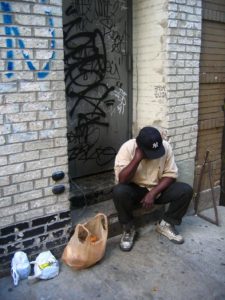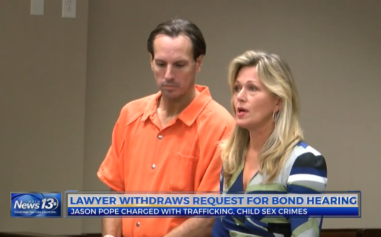
More Than a Survivor Exhibition in Rogue Valley. The art installation travels around the country for sex trafficking awareness. (Photo: Facebook)
Portraits of 22 different women lined the walls of Atlanta’s Hartsfield-Jackson International Airport in June. The temporary photography installation featured a diverse group of women, holding onto a symbol of who they are and who they aspire to be. One grasped a molecular model to represent her career in science, while another was draped in a cap and gown, illustrating the completion of her education.
Beside each portrait was a plaque that shared a story of that individual’s life. All featured a central theme: They were all survivors of sexual exploitation.
The exhibit is part of the traveling “More Than a Survivor” campaign, which is meant to depict survivors of sexual assault as more than just victims, but as scholars, scientist, photographers and more. But this isn’t the first attempt by Hartsfield-Jackson to bring awareness to human trafficking through art. In 2015, the airport revealed the exhibit “Freedom Expression ATL,” which was meant to raise awareness about the issue.
Human trafficking is the fastest-growing criminal issue in the world, and there is a misconception that it only occurs on foreign land. But the sad truth is, it’s right under our noses. Atlanta is one of the 14 U.S. cities, named by the FBI, with the highest rate of children used in sex trafficking, with the airport being a popular pickup spot for those who fall victim.
Homeless youths are particularly vulnerable to becoming victims of both sex and labor trafficking, and while they have often been seen as an invisible population, leaving them undercounted for years, they are anything but absent.
Between 2014 and 2016, researchers interviewed homeless youths from 10 Covenant House sites, a shelter for unoccupied youths, in the U.S. and Canada. The study showed that 19 percent of the 641 young people interviewed had been victims of trafficking — 14 percent were coerced into sex trafficking, while 8 percent had been trafficked for forced labor and 3 percent had been trafficked in both.

The Covenant House Study is the largest study done on human trafficking of homeless youths to date. (Photo by: U.S. Department of Agriculture)
“Some became involved because they had no place to live, they had no means to support themselves, no way to feed themselves and these were people who offered to provide those things that they couldn’t have had otherwise, and they really felt they had no choice. And some of them, when they realized the situation they were in, they were afraid to leave. They were threatened with their life and with their safety, and some of them couldn’t leave,” said Debra Schilling Wolfe, executive director of the Field Center for Children’s Policy, Practice & Research.
The majority of youth who had experienced some form of trafficking were vulnerable because of economic factors and found themselves desperate for work, making them susceptible to being taken advantage of. Others reported they feared sleeping on the streets, leaving them vulnerable to being trafficked in both sex and labor work. Nineteen percent of all the youths interviewed had engaged in “survival sex” — sex for food, housing or other basic necessities.
“Homeless young people stand out to the community, predators can identify who they are. They see their vulnerability and they approach them and try to take advantage of them,” Wolfe said. “And what stunned us were the sheer number that had been approached for sex on the very first night they were homeless. So, we know, as a population they are identified and targeted.”
While all homeless youths are vulnerable to trafficking, one group that stood as being disproportionately affected by trafficking was homeless LGBTQ youths. While only 19 percent of the respondents that were interviewed identified as LGBTQ, they accounted for 36 percent of sex trafficking victims.
Laura Murphy, the director of Loyola University’s Modern Slavery Research Project, believes this is because of the disproportionate number of homeless LGBTQ youths. (According to The Williams Institute, 40 percent of homeless youths identify as LGBTQ.) She also attributes it to the amount of workplace discrimination, which makes it difficult for them to have sustainable work and formal employment opportunities.
“I think that young people who are LGBT are particularly vulnerable around the ages of 16 and 18,” Murphy said. “It’s the average age of young people [entering the sex trade].

“Homeless youths and young adults are seen as an invisible population because they often go unnoticed by the broader community,” said Jessica Henry, clinical director of Covenant House Georgia.
“It’s really important that we look at how it’s economic factors and the lack of a social support network that make young people vulnerable to exploitation,” she said. “What really lacks attention are the things that young people actually need, like housing and jobs and a reasonable rate of pay, and sustainable living situations and support networks. That’s where we need to pay attention.”
For Murphy, these important aspects are what makes organizations like Covenant House even more important. The shelter houses homeless youths in 30 cities across six countries — the United States, Canada, Mexico, Guatemala, Honduras and Nicaragua.
Covenant House Georgia, located in Atlanta, works with 45 homeless youths between the ages 18 and 21 daily at its crisis shelter. All of them are allowed to stay until the age of 24.
The organization has a number of resources in place to reach out to youths who have been victims of trafficking and to help prevent it from occurring to those at risk. They offer outreach programs that provide information and resources on trafficking as well as food and other supplies. They also provide mental health services, both individual and group therapy focused on sexual exploitation and trauma.
“Many of our youths are unaware that they have been sexually exploited until they come to therapy and learn and process the definition of sex trafficking and begin to understand that their boyfriend or someone close to them was their exploiter or trafficker,” said Dr. Jessica Henry, clinical director of Covenant House Georgia.

Covenant House organizers sponsored a “Sleep Out,” in November 2016, where participates engage in an immersive experience to show solidarity with homeless youths. (Photo: Covenant House)
As for prevention, Wolfe believes the passing of Safe Harbor laws, which decriminalize prostitution and related charges for victims of sex trafficking, would be helpful. She also hopes to see an expansion of outreach services and support systems for young people who fall victim to homelessness.
Murphy’s focus is on the importance of funding. She believes it is important to put more resources into training law enforcement and social service providers. Funding for sustainable housing and job skill training programs, are also important investments to make for prevention, Murphy said.
“The thing we need to do is address the root problems, which are poverty and homelessness and poor education and lack of jobs. That’s really where it’s at,” Murphy said. “So long as legislators don’t want to fund that, they will continue to be responsible for trafficking. Funding is crucial.”
Individuals interested in helping homeless youths can get involved through volunteering, donating or visiting the Covenant House website.


